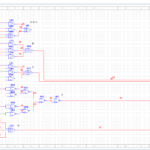Project Lead The Way Digital Electronics Resume
- Computational and Analytical Skills
- Use mathematical processes to convert any value between any number systems
- Calculate voltage, current, and/or resistance for components in a complex circuit
- Translate circuit designs, truth tables, design requirements into logic expressions
- Simplify circuits using Boolean algebra theorems and DeMorgan’s theorems
- Simplify a logic expression graphically using the Karnaugh Mapping process
- Digital Electronics Design Experience
- Implement the design process to design a circuit
- Design a circuit to meet voltage, current, or resistance design requirements
- Select components in a design to produce a desired waveform
- Implement the best combinational logic circuit design
- Apply knowledge of logic gates to select an appropriate gate for the circuit design
- Troubleshoot the design of a circuit by analysis and comparison to the truth table
- Implement a circuit design based on logic expressions
- Troubleshoot existing circuits based on logic expressions
- Determine when NAND only or NOR only implementations are the most efficient
- Implement a seven segment display into a circuit design
- Determine when a common cathode or common anode seven segment display may perform better in a
particular circuit design - Design a sequential circuit
- Describe the function of XOR/XNOR gates in a circuit design
- Design an adder/subtractor circuit related to the carry out and use on XOR gates
- Design a desired frequency of a clock signal in a 555 timer design
- Design a sequential logic circuit to produce a desired output
- Design synchronous/asynchronous counter circuits based on design requirements
- Design a state machine based on specific design requirements
- Design a circuit with motors as outputs that operate at different voltage levels
- Select and apply the most appropriate design method for circuit implementation
- Practical Application Experience
- Solder and de-solder components on printed circuit boards
- Validate circuit design through measurement using a probe/oscilloscope and analysis of timing diagram
- Select and apply the most appropriate technology for circuit implementation
- Implement designs on an FPGA
- Create a program to manage inputs and outputs of a microcontroller
- Tools and Software
- Oscilloscope
- DMM
- FPGA
- Digital Mini System
- Digital Logic Board
- Professional Skills
- Team collaboration
- Project management
- Problem-solving
- Communication skills
- Presentation skills
- Technical writing
- Course Knowledge
- Foundations of Electronics
- Introduction to safety, electricity, and components
- Introduction to common analog and digital circuit designs and applications
- Combinational Logic
- Designing AOI combinational logic circuits
- Alternative Design: Universal gates and K-mapping
- Specific combinational logic designs
- Introduction to PLD design and circuit prototyping on a PLD
- Sequential Logic
- Sequential logic circuit design
- D flip-flops, J/K flip-flops, and flip-flop applications
- Asynchronous counters
- Counter design SSI, MSI, and MOD asynchronous counters
- Synchronous counters
- Counter design SSI, MSI, and MOD synchronous counters
- Controlling Real World Systems
- Introduction to state machines
- Introduction to sensors, motors, and state machine design
- Introduction to microcontrollers



